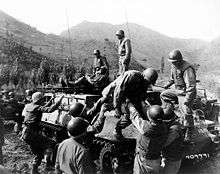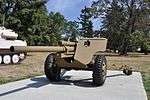M39 Armored Utility Vehicle
The M39 Armored Utility Vehicle (T41) was an American armored vehicle designed during the Second World War, which saw service in that conflict and in the Korean War. Like a number of vehicles of this type, it was built using an existing chassis, that of the M18 Hellcat.
| M39 Armored Utility Vehicle | |
|---|---|
 An M-39 Armored Utility Vehicle in the Korean War | |
| Type | Artillery tractor |
| Place of origin | United States |
| Service history | |
| In service | 1945-1960 |
| Used by | United States, West Germany |
| Wars | World War II, Korean War |
| Production history | |
| Designed | 1944 |
| Manufacturer | Buick division of General Motors |
| Produced | October 1944–March 1945 |
| No. built | 640 converted |
| Specifications | |
| Mass | 33,450 lb (15.17 metric tons) |
| Length | 17 ft 4 in (5.28 m) |
| Width | 9 ft 5 in (2.87 m) |
| Height | 6 ft 8 in (2.03 m) |
| Crew | 3 |
| Armor | 4.8-12.7 mm (0.19-0.5 in) |
Main armament | .50 caliber (12.7 mm) Browning M2HB machine gun 900 rounds |
| Engine | Continental R975-C4 9 cylinder radial gasoline engine, 400 hp (298 kW) at 2,400 rpm |
| Power/weight | 26.37 hp/metric ton |
| Transmission | 900T Torqmatic 3 speeds forward, 1 reverse |
| Suspension | Torsion bar |
| Fuel capacity | 165 US gallons (625 litres) |
Operational range | 100 miles (160 km) on road |
| Maximum speed | 50 mph (80 km/h) on road |
History
The M39 was originally designed as a prime mover for the 3-inch Gun M5. Approximately 650 (640 utility/APC variants, 10 command and reconnaissance) were modified from M18 chassis between October 1944 and March 1945. They saw service in Europe during the last months of World War II and were widely used during the Korean War, where they were employed in variety of roles, including as troop transports, medevac ambulances, and ammunition carriers for 155mm M41 Gorilla self-propelled howitzers. M39s played a vital role in supplying and ferrying troops to isolated outposts during the later defensive phase of the Korean War, though their thin armor and open tops meant the crew were vulnerable to enemy fire, and the fully enclosed M75 armored personnel carrier would eventually replace it in this role.[1] The M39 was withdrawn from U.S. service in 1957.
Ambush in the Battle of Imjin River
M39s were employed as ammunition carriers in the African American 999th Armored Field Artillery Battalion, which fought in the Battle of the Imjin River, where it provided artillery support for the 1st Republic of Korea Infantry Division. During the battle, Battery B was forced to evacuate its position after neighboring units withdrew. Because the M39s carriers had .50 caliber machine guns, unlike the unit's M41 self-propelled howitzers, they led the retreating column. During the retreat, it was ambushed by Chinese forces; in the battle, the unit lost 7 killed in action, 2 M39 Armored Utility Vehicles and had two M41s damaged and 31 wounded. However, the unit broke through the ambush, inflicting an estimated 100 casualties on the ambushing forces, and promptly resumed providing artillery support afterwards.[2]
Use in the Bundeswehr
In 1956 the United States offered 100 M39s to the West German Bundeswehr. Only 32 were put into service and they were assigned to the Panzergrenadier-Lehrbataillon in Munster. After four years of service they were replaced in 1960 by the Schützenpanzer Lang HS.30 due to a shortage of spare parts.[3]
Gallery
 Medical corpsmen assist in helping wounded infantrymen down from an M39 Armored Utility Vehicle.
Medical corpsmen assist in helping wounded infantrymen down from an M39 Armored Utility Vehicle. M39 Armored Utility Vehicle.
M39 Armored Utility Vehicle.- A U.S. Army M39 assists U.S. Marines picking up casualties on 25 July 1953 during an attack against Hill 111, also known as "Boulder City," during the Battle of the Samichon River during the Korean War.
 M5 3-inch antitank gun
M5 3-inch antitank gun
See also
References
- "M39 Armored Utility Vehicle". Military Encyclopedia of the Web. Retrieved 30 March 2016.
- Bowers, William T. (2011). Passing the Test: Combat in Korea April-June 1951. University Press of Kentucky. pp. 39–58. ISBN 978-0-8131-3452-9. Retrieved 30 March 2016.
- "SPz M39 (Bw)". www.panzerbaer.de. Retrieved 21 February 2017.